-
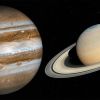 +4 +1
+4 +1Jupiter and Saturn will come within 0.1 degrees of each other, forming the first visible "double planet" in 800 years
Before 2020 comes to a close, Jupiter and Saturn will be so close that they will appear to form a "double planet." The great conjunction, as the planetary alignment has come to be known, hasn't occurred in nearly 800 years. When their orbits align every 20 years, Jupiter and Saturn get extremely close to one another. This occurs because Jupiter orbits the sun every 12 years, while Saturn's orbit takes 30 years — every couple of decades, Saturn is lapped by Jupiter, according to NASA.
-
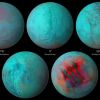 +19 +1
+19 +1Saturn's ocean moon Enceladus has fresh ice in unexpected place
Enceladus may be even more interesting than we thought.
-
 +21 +1
+21 +1Saturn's moon Titan is rapidly migrating away from the planet
Titan, Saturn's largest moon, is moving away from its planet a hundred times faster than previously established, according to a new study. This could change the way scientists understand the evolution of Saturn's planetary system.
-
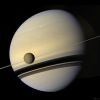 +11 +1
+11 +1Your Guide to Saturn
The real Lord of the Rings is Saturn, a massive outer planet boasting a set of rings about 27 Earths wide. Being a gas giant like Jupiter, Saturn shares many of its attributes: a strong magnetic field generated by churning metallic hydrogen deep inside, raging storms in its gaseous upper atmosphere, and a diversity of planet-like moons that are worlds unto themselves. Saturn’s rings and larger moons are visible even from small backyard telescopes.
-
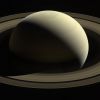 +12 +1
+12 +1Discovery of 20 new moons gives Saturn a solar system record
With its newfound companions, Saturn nudges out Jupiter as the planet with the most known moons in our cosmic neighborhood.
-
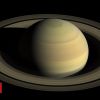 +13 +1
+13 +1Saturn becomes planet with most moons
Jupiter had been the "moon king" for some 20 years.
-
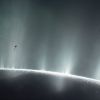 +20 +1
+20 +1Saturn's Icy Moon Enceladus Is Likely the 'Perfect Age' to Harbor Life
It's probably around 1 billion years old.
-
 +28 +1
+28 +1Fusion-Powered Spacecraft Could Be Just a Decade Away
The tech could allow a probe to make it to Saturn in just two years.
-
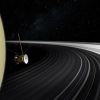 +6 +1
+6 +1How Old Are Saturn's Rings? The Debate Rages On
Of our solar system’s wonders, one reigns as the emblem of all that is alien and otherworldly: the majestic rings of Saturn, rising resplendent and shimmering above the giant planet’s buttery, cloud-crossed face. Stretching nearly 300,000 kilometers from tip to tip and containing countless icy particles ranging in size from “microscopic” to “mobile home,” the rings make Saturn undeniably eye-catching. But more than mere decoration, they are one of the most enduring enigmas in planetary science.
-
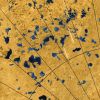 +10 +1
+10 +1Saturn's Moon Titan May Have 'Phantom Lakes' and Caves
Picture a world where rain falls, gathers in lakes and ponds, seeps into the surrounding rock, and evaporates away, only to fall again. There's just one catch: The world is Saturn's moon, Titan, where the rain isn't water; it's liquid methane. Two new papers explore how this eerily familiar, waterless "water cycle" manifests on Titan's surface. To do so, two separate research teams turned to data from the Cassini mission, which ended its stay at the Saturn system in September 2017.
-
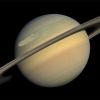 +25 +1
+25 +1The Moon slides by Saturn tomorrow morning
The Moon moves eastward relative to the background stars an average of 13° every day, and early tomorrow morning (Friday, March 29), Earth’s only satellite will pass within just 3° of Saturn. The ringed planet rises around 3:15 a.m. local daylight time over the southeastern horizon. The Moon, which currently appears as a waning crescent, follows about 10 minutes later.
-
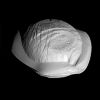 +12 +1
+12 +1Saturn's small moons formed from the dust of its rings
NASA’s Cassini mission to Saturn may have ended in 2017, but researchers are still analyzing the vast amount of data it sent back over its final spectacular months. Astronomers most recent findings, published Thursday, center on five of Saturn’s small ring moons: Pan, Daphnis, Atlas, Pandora and Epimetheus. During six close flybys near the end of its mission, Cassini uncovered new insights into how the moons formed, and what gives them their different colors.
-
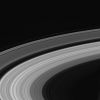 +12 +1
+12 +1Waves in Saturn's rings give precise measurement of planet's rotation rate
Saturn's distinctive rings were observed in unprecedented detail by NASA's Cassini spacecraft, and scientists have now used those observations to probe the interior of the giant planet and obtain the first precise determination of its rotation rate. The length of a day on Saturn, according to their calculations, is 10 hours 33 minutes and 38 seconds.
-
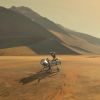 +33 +1
+33 +1NASA May Decide This Year to Land a Drone on Saturn's Moon Titan
Scientists want to return to Saturn's moon Titan to investigate its complex chemistry — this time buoyed by Earth's fascination with drone technology.
-
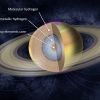 +13 +1
+13 +1Saturn hasn't always had rings
One of the last acts of NASA's Cassini spacecraft before its death plunge into Saturn's hydrogen and helium atmosphere was to coast between the planet and its rings and let them tug it around, essentially acting as a gravity probe. Precise measurements of Cassini's final trajectory have now allowed scientists to make the first accurate estimate of the amount of material in the planet's rings, weighing them based on the strength of their gravitational pull.
-
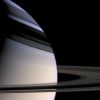 +12 +1
+12 +1Rings make Saturn shadier, bluer and less hazy in winter
On Saturn, changing seasons can mean changes in the haziness—and color—of the skies. In the 13 years the Cassini spacecraft orbited Saturn, from 2004 to 2017, scientists noticed the atmosphere in the planet's northern hemisphere turned from blue-tinted to gold or even salmon. The stark color shift came from changes in the amount of sunlight-triggered haze in Saturn's atmosphere, according to new research.
-
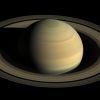 +19 +1
+19 +1Saturn's Rings Are Beautiful, But They Won't Last
Saturn's rings are disappearing — and fast.
-
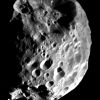 +10 +1
+10 +1Saturn and Its Moons Have Water Just Like Earth's — Except for Phoebe
Although we weren’t here to observe the birth of our own solar system, astronomers have developed a relatively informed picture of how it likely happened, based on observations of our present-day home and the infant planets forming around other stars. But every so often, something throws a wrench in our theories, and that may have just happened — researchers have discovered interesting new properties of Saturn and its moons that contradict our current models for how the solar system formed.
-
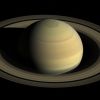 +19 +1
+19 +1Saturn's rings made of surprising chemical mix
Political humorist Mark Russel once joked, “The scientific theory I like best is that the rings of Saturn are composed entirely of lost airline luggage.” Well, there’s no luggage, it turns out. But a new study appearing in Science based on data from the final orbits last year of NASA’s Cassini spacecraft shows the rings of Saturn — some of the most visually stupendous objects in the universe — are far more chemically complicated than previously was understood.
-
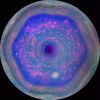 +10 +1
+10 +1Saturn's Famous Hexagon May Tower Above the Clouds
A new long-term study using data from NASA's Cassini spacecraft has revealed a surprising feature emerging at Saturn's northern pole as it nears summertime: a warming, high-altitude vortex with a hexagonal shape, akin to the famous hexagon seen deeper down in Saturn's clouds. The finding, published Sept. 3 in Nature Communications, is intriguing, because it suggests that the lower-altitude hexagon may influence what happens above, and that it could be a towering structure hundreds of miles in height.
Submit a link
Start a discussion




















